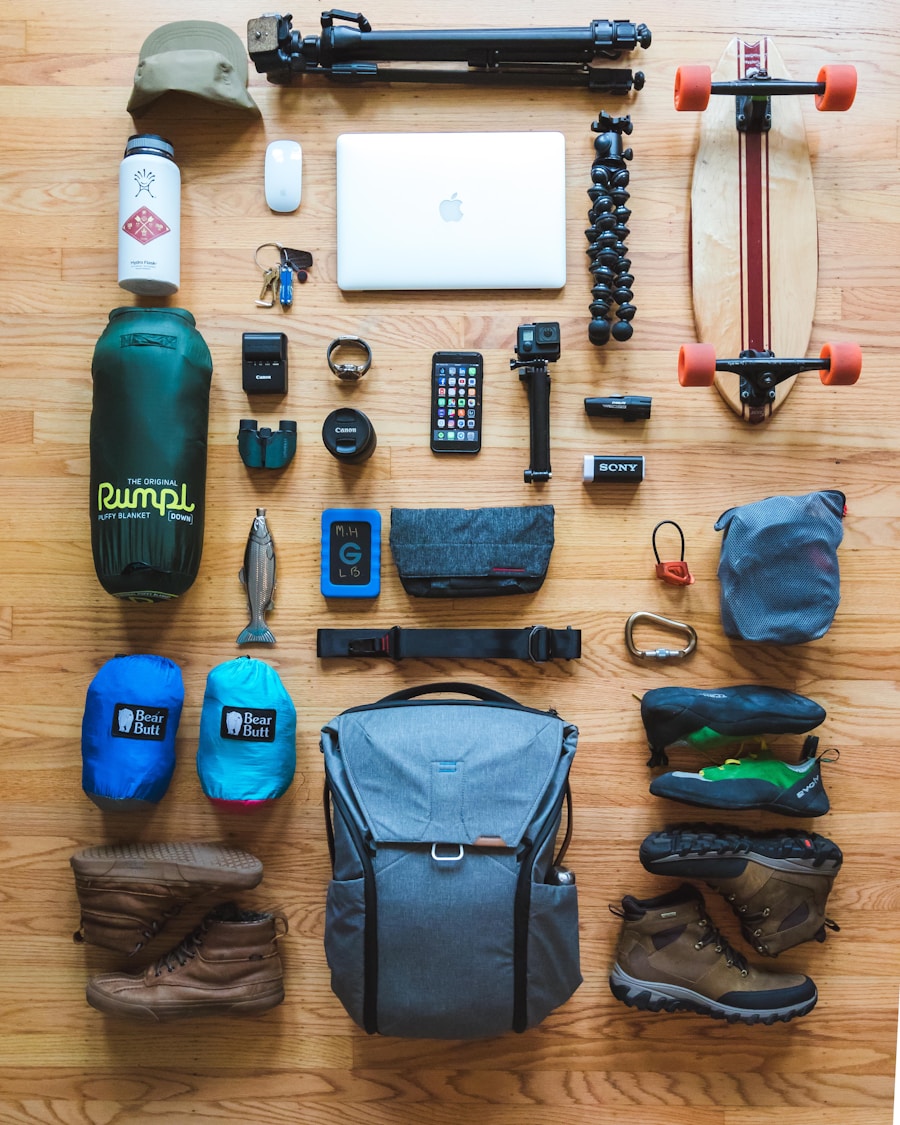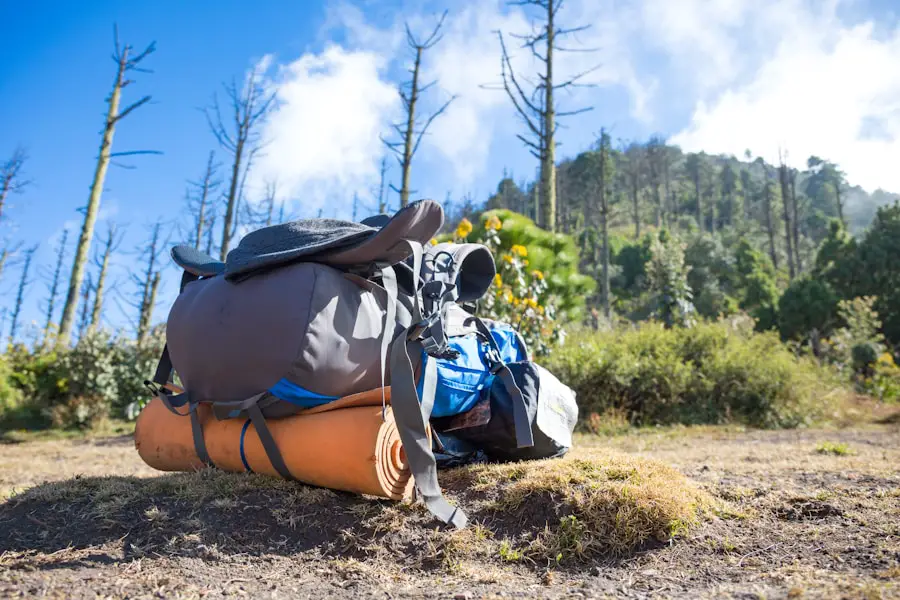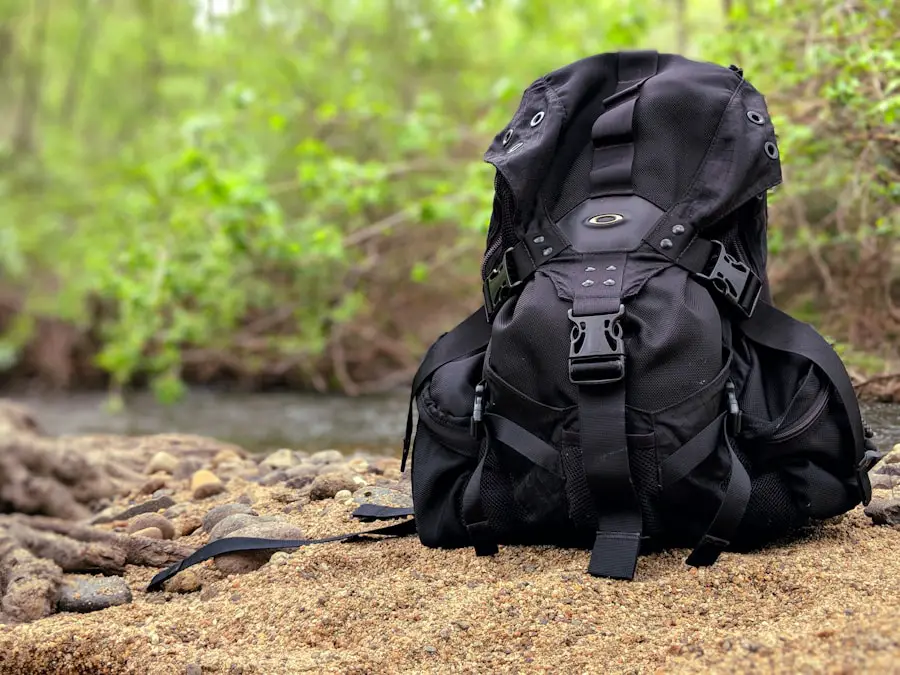Selecting the appropriate backpack is a critical first step in preparing for any hiking adventure. The right backpack not only enhances your comfort but also significantly impacts your overall hiking experience. When choosing a backpack, consider the duration of your hike, the terrain, and the amount of gear you need to carry.
For day hikes, a smaller pack with a capacity of 20 to 30 liters is often sufficient, allowing you to carry essentials without being weighed down. Conversely, for multi-day treks, a larger backpack with a capacity of 50 to 70 liters is advisable, providing ample space for sleeping gear, food, and other necessities. Another important factor to consider is the fit of the backpack.
A well-fitted backpack should sit comfortably on your back without causing strain or discomfort. Look for adjustable straps, padded hip belts, and a supportive frame that can distribute weight evenly across your body. Many outdoor retailers offer fitting services, allowing you to try on various models and find one that suits your body type.
Additionally, consider the features that may enhance your hiking experience, such as hydration reservoirs, external pockets for easy access to gear, and weather-resistant materials that can withstand the elements.
Key Takeaways
- Choose a backpack with adjustable straps and proper back support for a comfortable hike
- Use packing cubes and compartments to organize gear and essentials for easy access
- Pack light for day hikes and bring extra layers and emergency supplies for longer hikes
- Distribute weight evenly in your backpack and adjust straps for a balanced load
- Utilize space efficiently by rolling clothes and using compression sacks for bulky items
Organizing Your Gear and Essentials
Once you have selected the right backpack, the next step is to organize your gear and essentials effectively. Proper organization not only makes it easier to find what you need while on the trail but also helps in maintaining balance and comfort while hiking. Start by categorizing your items into groups: clothing, cooking equipment, first aid supplies, navigation tools, and personal items.
This method allows you to quickly locate specific items without rummaging through your entire pack. Utilizing packing cubes or dry bags can significantly enhance organization within your backpack. These containers help keep similar items together and can be easily pulled out when needed.
For instance, keep all cooking gear in one cube and clothing in another. Additionally, consider using the outer pockets of your backpack for items you may need quick access to, such as snacks, maps, or a rain jacket. This way, you won’t have to dig deep into your pack when you need something urgently.
Packing for Different Types of Hikes

The type of hike you are embarking on will dictate how you pack your backpack. For short day hikes on well-marked trails, packing light is key. Focus on essentials such as water, snacks, a first aid kit, and a lightweight jacket.
The goal is to minimize weight while ensuring you have everything necessary for a safe and enjoyable outing. A day hike typically requires less gear than an overnight trek, allowing for a more streamlined packing approach. In contrast, multi-day hikes require more extensive preparation and packing strategies.
When planning for longer excursions, consider the weight of each item carefully. Opt for lightweight camping gear and dehydrated meals that can save space and reduce weight. It’s also essential to pack extra clothing layers to accommodate changing weather conditions and ensure comfort during the hike.
Organizing your food into daily rations can help manage space and make meal preparation easier at camp. Each type of hike presents unique challenges and requirements; understanding these will help you pack appropriately.
Distributing Weight and Balancing Your Backpack
| Backpack Weight Distribution | Importance |
|---|---|
| Evenly distributing weight | Prevents strain on one side of the body |
| Keeping heavier items closer to the body | Improves balance and stability |
| Using hip belt to transfer weight to hips | Reduces strain on shoulders and back |
| Adjusting shoulder straps and sternum strap | Ensures proper fit and weight distribution |
Weight distribution is a crucial aspect of packing that can greatly affect your comfort and stability while hiking. A well-balanced backpack allows for better movement and reduces fatigue over long distances. The general rule of thumb is to keep heavier items close to your back and centered within the pack.
This positioning helps maintain your center of gravity and prevents unnecessary strain on your shoulders and back. When packing your backpack, place heavier items such as water bottles or cooking equipment at the bottom or in the middle of the pack. Lighter items like clothing or sleeping bags can be placed at the top or in external pockets.
Additionally, ensure that any frequently used items are easily accessible without disrupting the overall balance of the pack. By taking the time to distribute weight thoughtfully, you can enhance your hiking experience significantly.
Maximizing Space and Efficiency
Maximizing space within your backpack is essential for efficient packing, especially on longer hikes where every ounce counts. One effective strategy is to utilize every available space within your pack. For instance, stuff small items like socks or gloves into shoes or gaps between larger items to prevent them from shifting during transit.
Compression sacks can also be beneficial for reducing the volume of bulkier items like sleeping bags or jackets. Another way to maximize space is by employing a modular packing system. This involves using various sizes of bags or containers that can be easily rearranged or removed as needed.
For example, if you have a separate bag for cooking supplies, it can be taken out when setting up camp without having to unpack everything else. This approach not only saves space but also enhances efficiency when accessing gear throughout your hike.
Essential Items to Pack for Safety and Comfort

Safety should always be a top priority when packing for a hike. Essential items include a first aid kit equipped with bandages, antiseptic wipes, pain relievers, and any personal medications you may need. A multi-tool or knife can also be invaluable for various tasks on the trail, from food preparation to emergency repairs.
Additionally, carrying a whistle can be crucial in case of emergencies; it serves as an effective signaling device if you become lost or injured. Comfort items are equally important for an enjoyable hiking experience. A lightweight sleeping pad can provide insulation and cushioning during overnight trips, while a quality sleeping bag ensures warmth during cooler nights.
Don’t forget about personal hygiene items such as biodegradable soap and toilet paper; these may seem minor but can significantly enhance your comfort level on longer hikes. Furthermore, consider packing a portable charger or power bank if you plan to use electronic devices for navigation or photography.
Tips for Packing Food and Water
When it comes to food and water, proper packing techniques can make all the difference in maintaining energy levels during your hike. For food, opt for lightweight options that are easy to prepare and consume on the go. Dehydrated meals are popular among hikers due to their low weight and compact size; simply add hot water to rehydrate them at camp.
Additionally, consider packing high-energy snacks such as nuts, energy bars, or dried fruits that provide quick fuel during breaks. Water management is another critical aspect of packing for hikes. Depending on the length of your hike and availability of water sources along the trail, you may need to carry multiple liters of water.
Hydration bladders are an excellent option as they allow for hands-free drinking while walking; however, ensure that they are easily accessible in case you need to refill them at water sources. If you’re hiking in areas where water purification is necessary, don’t forget to pack a reliable filtration system or purification tablets.
Final Checklist Before Hitting the Trail
Before embarking on your hiking adventure, it’s essential to conduct a final checklist to ensure that you have everything you need packed efficiently and securely in your backpack. Start by reviewing your gear list against what you have packed; this includes checking off essential items such as navigation tools (maps and compass), safety equipment (first aid kit), cooking supplies (stove and fuel), and personal items (clothing layers). Next, double-check that all compartments of your backpack are securely closed and that nothing is protruding that could snag on branches or rocks along the trail.
Ensure that any food items are sealed properly to avoid attracting wildlife during your hike. Finally, take a moment to assess your physical readiness; ensure that you are hydrated and have eaten adequately before hitting the trailhead. With everything in order, you’ll be well-prepared to enjoy the great outdoors with confidence and peace of mind.
If you’re planning a hiking trip, it’s essential to know how to pack your backpack efficiently. One helpful article to check out is “The Best Time to Travel to Bali: A Seasonal Guide” which provides insights on the ideal times to visit Bali for hiking and other outdoor activities. By following the tips in this article, you can ensure that you have everything you need for a successful and enjoyable hiking adventure in Bali. Check out the article here.
FAQs
What should I consider when packing my hiking backpack?
When packing your hiking backpack, consider the weight distribution, accessibility of items, and the weather conditions of your hiking destination. It’s important to pack essential items such as water, food, first aid kit, navigation tools, and appropriate clothing.
How should I distribute the weight in my hiking backpack?
Distribute the weight in your hiking backpack evenly to maintain balance and stability. Place heavier items closer to your back and towards the middle of the backpack. Lighter items can be placed towards the outside and at the top of the backpack.
What are some essential items to pack in my hiking backpack?
Essential items to pack in your hiking backpack include water, food, first aid kit, navigation tools (map, compass, GPS), extra clothing, sun protection (sunscreen, hat, sunglasses), and emergency supplies (whistle, flashlight, fire starter).
How can I ensure easy access to items in my hiking backpack?
To ensure easy access to items in your hiking backpack, use compartments and pockets to organize your gear. Pack frequently used items in easily accessible pockets and keep less frequently used items towards the bottom of the backpack.
What should I consider when packing for different weather conditions?
When packing for different weather conditions, consider the forecasted temperature, precipitation, and terrain of your hiking destination. Pack appropriate clothing layers, rain gear, and extra insulation for colder temperatures. It’s also important to pack sun protection for hot and sunny conditions.
